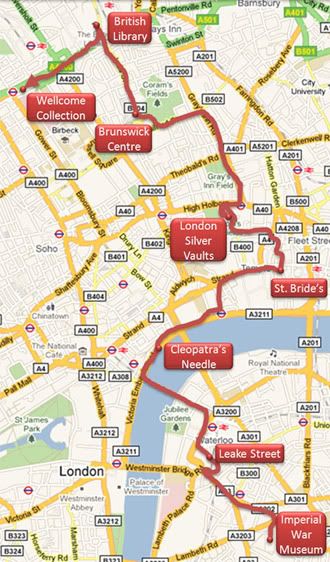
The rendez-vous was 10:15 inside the World War I trenches of the Imperial War Museum ...
Imperial War Museum
... but this proved impossible, because apart from the superb visual reproduction of the trenches they have even emulated the smell too!


After everyone arrived, we took a quick look at some of the exhibits, such as the midget submarine with the external torpedo and T.E. Lawrence's motorcycle, and headed north.


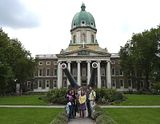
Leake Street
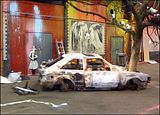 First stop, Leake Street. In May 2008, Banksy and several other notable street artists, organised the Cans Festival, an urban art festival in the abandoned tunnel of Leake Street. Today, it is the only place in London where graffiti is tolerated. Most of the original artwork has disappeared under low-quality graffiti signatures of Banksy-wannabes, but some good examples have survived.
First stop, Leake Street. In May 2008, Banksy and several other notable street artists, organised the Cans Festival, an urban art festival in the abandoned tunnel of Leake Street. Today, it is the only place in London where graffiti is tolerated. Most of the original artwork has disappeared under low-quality graffiti signatures of Banksy-wannabes, but some good examples have survived.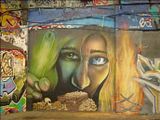
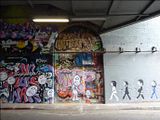
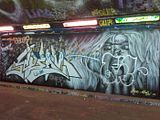
Cleopatra's Needle
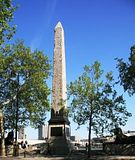 It has little to do with Cleopatra, but it got the name from the Victorian equivalent of marketing people, who wanted to attract more attention by associating it with her. In fact, it was built much earlier, in Tuthmose III's reign to commemorate his continued rule as a pharaoh. Later inscriptions were added by Ramesses II to commemorate his victories.
It has little to do with Cleopatra, but it got the name from the Victorian equivalent of marketing people, who wanted to attract more attention by associating it with her. In fact, it was built much earlier, in Tuthmose III's reign to commemorate his continued rule as a pharaoh. Later inscriptions were added by Ramesses II to commemorate his victories.The four plaques mounted around the base:
THIS OBELISK QUARRIED AT SYENE WAS ERECTED AT ON (HELIOPOLIS) BY THE PHARAOH THOTHMES III IN ABOUT 1500 B.C. LATERAL INSCRIPTIONS WERE ADDED NEARLY TWO CENTURIES LATER BY RAMESES THE GREAT REMOVED DURING THE GREEK DYNASTY TO ALEXANDRIA THE ROYAL CITY OF CLEOPATRA IT WAS THERE ERECTED IN THE 18th YEAR OF AUGUSTUS CAESAR B.C. 12
THIS OBELISK PROSTRATE FOR CENTURIES WAS PRESENTED TO THE BRITISH NATION A.D. 1819 BY MAHOMMED ALI VICEROY OF EGYPT A WORTHY MEMORIAL OF OUR DISTINGUISHED COUNTRYMEN NELSON AND ABERCROMBY
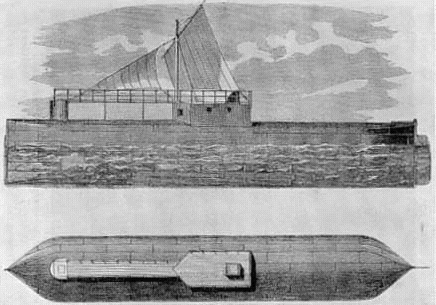
THROUGH THE PATRIOTIC ZEAL OF ERASMUS WILSON F.R.S. WAS BROUGHT FROM ALEXANDRIA ENCASED IN AN IRON CYLINDER IT WAS ABANDONED DURING A STORM IN THE BAY OF BISCAY RECOVERED AND ERECTED ON THIS SPOT BY JOHN DIXON C.E. IN THE 42nd YEAR OF THE REIGN OF QUEEN VICTORIA 1879
WILLIAM ASKIN - MICHAEL BURNS JAMES GARDINER - WILLIAM DONALD JOSEPH BENTON - WILLIAM PATAN PERISHED IN A BOLD ATTEMPT TO SUCCOUR THE CREW OF THE OBELISK SHIP CLEOPATRA DURING THE STORM OCTOBER 14th 1877
Another QI (quite interesting) fact: It is said that on erection of the obelisk in 1878, a time capsule was concealed in the front part of the pedestal, containing:
photographs of the 12 most beautiful English women of the time, a box of cigars, several tobacco pipes, a babies bottle, some children's toys, a shilling razor, British coins, a portrait of Queen Victoria, copies of the bible in several languages, a map of London, newspapers, etc.
The plan was to visit the London Roman Bath next, but since access was locked for some unknown reason, we moved on to Fleet Street.
Strand / Fleet Street
Fleet Street began as the road from the commercial City of London to the political hub at Westminster. In fact, the length of Fleet Street marks the expansion of the City in the 14th century.
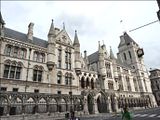 To the south lies an area of legal buildings known as the Temple, formerly the property of the Knights Templar, which at includes two of the four Inns of Court: the Inner Temple and the Middle Temple. There are many lawyers' offices in the vicinity. Nearby, on Strand, are the Royal Courts of Justice (photo). Ludgate Circus Publishing started in Fleet Street around 1500 when Wynkyn de Worde set up a printing shop near Shoe Lane, while at around the same time Richard Pynson set up as publisher and printer next to St Dunstan's church. More printers and publishers followed, mainly related to the legal trade. In March 1702, London's first daily newspaper, The Daily Courant, was published in Fleet Street from premises above the White Hart Inn. Today, Fleet Street is associated more with the law than printing, since almost all of the newspapers moved to Wapping and Canary Wharf.
To the south lies an area of legal buildings known as the Temple, formerly the property of the Knights Templar, which at includes two of the four Inns of Court: the Inner Temple and the Middle Temple. There are many lawyers' offices in the vicinity. Nearby, on Strand, are the Royal Courts of Justice (photo). Ludgate Circus Publishing started in Fleet Street around 1500 when Wynkyn de Worde set up a printing shop near Shoe Lane, while at around the same time Richard Pynson set up as publisher and printer next to St Dunstan's church. More printers and publishers followed, mainly related to the legal trade. In March 1702, London's first daily newspaper, The Daily Courant, was published in Fleet Street from premises above the White Hart Inn. Today, Fleet Street is associated more with the law than printing, since almost all of the newspapers moved to Wapping and Canary Wharf.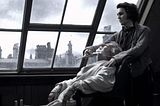 Fleet Street is also famous for the barber Sweeney Todd, traditionally said to have lived and worked in Fleet Street. An early example of a serial killer, he appears in various English language works starting in the mid-19th century. Neither the popular press, the Old Bailey trial records, the trade directories of the City nor the lists of the Barbers Company of the City mention any such person or any such case. So, it is probably nothing more than a literary product.
Fleet Street is also famous for the barber Sweeney Todd, traditionally said to have lived and worked in Fleet Street. An early example of a serial killer, he appears in various English language works starting in the mid-19th century. Neither the popular press, the Old Bailey trial records, the trade directories of the City nor the lists of the Barbers Company of the City mention any such person or any such case. So, it is probably nothing more than a literary product.St Bride's
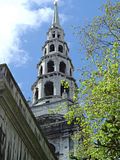 One of the 51 churches that Christopher Wren built in the City after the Great Fire of 1666. The church has always been associated with famous Fleet Street journalists and other famous figures, such as Milton and Pepys. Interestingly, it is said that a local baker, William Rich, modelled his daughter's wedding cake on the church's spire. Other bakers followed suit and the tradition lives on.
One of the 51 churches that Christopher Wren built in the City after the Great Fire of 1666. The church has always been associated with famous Fleet Street journalists and other famous figures, such as Milton and Pepys. Interestingly, it is said that a local baker, William Rich, modelled his daughter's wedding cake on the church's spire. Other bakers followed suit and the tradition lives on.In 1764 the spire was struck by lightning, which reduced its height by 8 feet. Benjamin Franklin was asked to advise King George III on the installation of lightning rods. Franklin suggested installing conductors with pointed ends, but the King wanted blunt ones. The King got his way, of course and the British press published propaganda praising the King "as good blunt honest George" contrary to Franklin, the "sharp-witted colonist".
London Silver Vaults
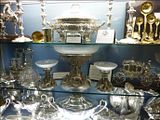 The Chancery Lane Safe Deposit opened in 1876, renting vaults to London's wealthy elite to safeguard their household silver, jewellery and personal documents. The business remained the same for several years, but with the original clients gradually replaced by silver dealers who required secure premises for their stock. This need was made more pressing by the outbreak of the Second World War. The building above the vaults was struck directly with a bomb during the war and was destroyed, but this did not damage the vaults at all.
The Chancery Lane Safe Deposit opened in 1876, renting vaults to London's wealthy elite to safeguard their household silver, jewellery and personal documents. The business remained the same for several years, but with the original clients gradually replaced by silver dealers who required secure premises for their stock. This need was made more pressing by the outbreak of the Second World War. The building above the vaults was struck directly with a bomb during the war and was destroyed, but this did not damage the vaults at all.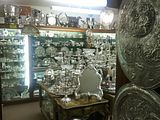 Knowledge of the Vaults began to spread and visitors from overseas started coming for quality silver at competitive prices. The rapid expansion of this business led to many more dealers renting a vault within the now world renowned London Silver Vaults and it has been in its present format since 1953. All shops have been owned by the same families for over 50 years.
Knowledge of the Vaults began to spread and visitors from overseas started coming for quality silver at competitive prices. The rapid expansion of this business led to many more dealers renting a vault within the now world renowned London Silver Vaults and it has been in its present format since 1953. All shops have been owned by the same families for over 50 years.Walking towards King's Cross we take a break at the Brunswick Centre. Surprisingly for its modernist architecture, this complex achieved Grade II status in 2000. Then, on the way to King's Cross we come across live puppet theatre on Judd Street.
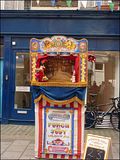
British Library
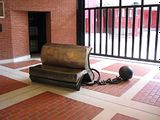 This is the largest library in the world. We visited it for the Sir John Ritblat Gallery, which exhibits some extremely importable items, such as the Codex Sinaiticus, one of the four surviving Magna Cartas, Lewis Carroll's "Alice's Adventures Under Ground", working manuscripts by Bach and Mozart, and even handwritten lyric sheets of The Beatles.
This is the largest library in the world. We visited it for the Sir John Ritblat Gallery, which exhibits some extremely importable items, such as the Codex Sinaiticus, one of the four surviving Magna Cartas, Lewis Carroll's "Alice's Adventures Under Ground", working manuscripts by Bach and Mozart, and even handwritten lyric sheets of The Beatles.Wellcome Collection
The Wellcome Trust was founded by Sir Henry Solomon Wellcome (1853–1936), an enthusiastic traveller, who amassed a huge collection of books, paintings and objects related to medicine. Not being very familiar with the medical world, this is one of the most unusual collections of exhibits I have ever seen; from tattooed skin taken from executed criminals to videos showing operations, and Darwin's stick.

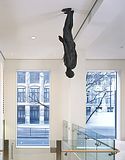
An unusual place to finish the walk. Like everything medical, it is not for the overly squeamish and not everyone likes its eccentric character. However, what everyone agreed on is that it has one of the best museum coffee shops, and this makes it a decent place to relax after a long walk.